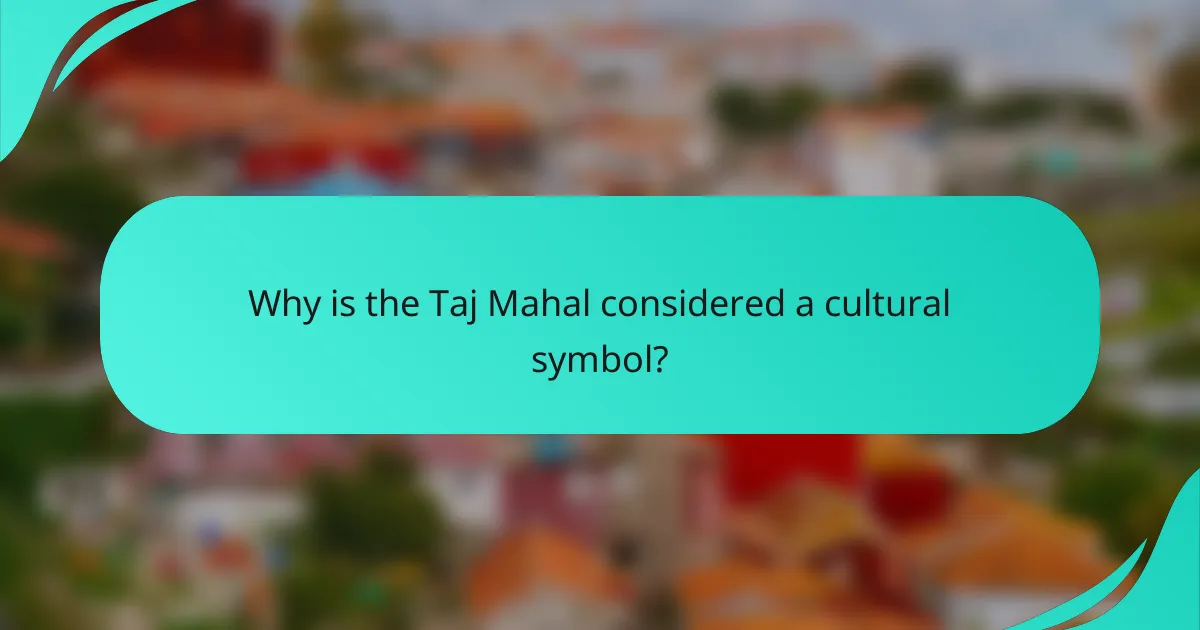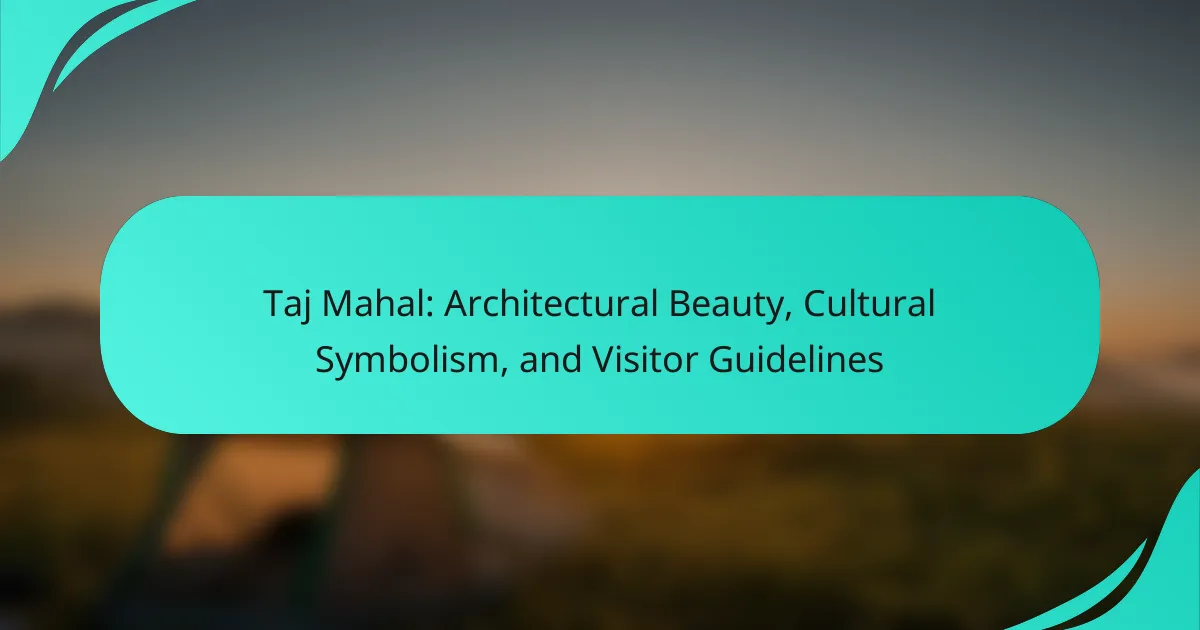The Taj Mahal stands as a testament to architectural beauty and cultural symbolism. This UNESCO World Heritage Site features a harmonious design, blending Persian, Islamic, and Indian styles. Visitors will learn about its unique craftsmanship and historical significance, alongside essential guidelines for an enjoyable experience. Discover how to appreciate this iconic monument while respecting its cultural heritage.

What architectural principles define the Taj Mahal?
The architectural principles defining the Taj Mahal include symmetry, grandeur, and intricate detail. Its design follows a perfect geometric layout, emphasizing harmony and balance. The use of white marble enhances its beauty, reflecting light in various shades. Additionally, the incorporation of Persian, Islamic, and Indian architectural elements creates a unique cultural synthesis.
How does symmetry enhance its aesthetic appeal?
Symmetry enhances the aesthetic appeal of the Taj Mahal by creating balance and harmony in its design. The symmetrical layout emphasizes its grandeur and evokes a sense of tranquility. This architectural feature is evident in the equal proportions of its minarets and the reflection in the surrounding water. Such symmetry is a unique attribute that contributes significantly to its status as an iconic cultural symbol. Visitors often find themselves captivated by this visual perfection, which enhances their overall experience.
Which materials were used in its construction?
The Taj Mahal was constructed using white marble, red sandstone, and precious gemstones. White marble sourced from Makrana, Rajasthan, is the primary material, giving it a stunning appearance. Red sandstone from the region enhances the structure’s intricate designs. Additionally, semi-precious stones like lapis lazuli and jade were used for inlay work, showcasing unique craftsmanship.
What role does the garden play in its overall design?
The garden plays a crucial role in the Taj Mahal’s overall design by enhancing its aesthetic appeal and symbolizing paradise. This meticulously designed garden, known as the Charbagh, represents the Islamic concept of paradise on earth. It features symmetrical layouts, reflecting pools, and pathways that guide visitors towards the mausoleum, creating a harmonious balance between nature and architecture. The garden’s layout also emphasizes the Taj Mahal’s grandeur, making it a central focal point for visitors, thereby enriching their experience.

Why is the Taj Mahal considered a cultural symbol?
The Taj Mahal is considered a cultural symbol due to its representation of love and its architectural excellence. Built in the 17th century by Emperor Shah Jahan in memory of his wife Mumtaz Mahal, it embodies Mughal architecture, blending Persian, Islamic, and Indian styles. The monument is a UNESCO World Heritage Site, attracting millions of visitors annually, which underscores its significance in global culture. Its intricate marble work and serene gardens enhance its status as an enduring symbol of romance and beauty.
How does it represent love and loss in its history?
The Taj Mahal represents love and loss through its creation as a mausoleum for Mumtaz Mahal, symbolizing enduring devotion. This architectural masterpiece embodies the grief of Shah Jahan, reflecting his profound love and the sorrow of her passing. The intricate designs and gardens enhance its emotional resonance, making it a universal symbol of love. Visitors often feel a deep connection to the story behind its construction, reinforcing its significance in cultural history.
What significance does it hold in Indian heritage?
The Taj Mahal holds immense significance in Indian heritage as an iconic symbol of love and architectural brilliance. This UNESCO World Heritage Site represents Mughal architecture, blending Persian, Islamic, and Indian styles. Its intricate craftsmanship and stunning white marble façade reflect the artistry of the era. Additionally, the Taj Mahal serves as a cultural symbol, attracting millions of visitors annually, and embodying India’s rich historical narrative. Its status as a mausoleum for Mumtaz Mahal emphasizes themes of devotion and loss, making it a profound representation of human emotion in art.
How is it perceived in global contexts?
The Taj Mahal is perceived globally as an iconic symbol of love and architectural excellence. Its intricate design and historical significance attract millions of visitors each year. The monument’s white marble façade reflects different hues throughout the day, enhancing its beauty. In various cultures, it represents enduring love and devotion, often featured in art and literature. The Taj Mahal’s status as a UNESCO World Heritage Site further emphasizes its global importance and cultural value.

What unique features differentiate the Taj Mahal from other monuments?
The Taj Mahal is distinguished by its unique architectural features, intricate craftsmanship, and symbolic significance. Its white marble façade, adorned with detailed inlay work, sets it apart from other monuments. The monument’s symmetrical design and the use of Persian architectural elements contribute to its status as a UNESCO World Heritage Site. Additionally, the Taj Mahal serves as a mausoleum, symbolizing love and loss, which is a rare attribute among global landmarks. Its reflective pools and gardens enhance the serene atmosphere, making it a sought-after destination for visitors.
How do the intricate carvings contribute to its uniqueness?
The intricate carvings enhance the Taj Mahal’s uniqueness by showcasing exceptional craftsmanship and cultural significance. These detailed designs reflect the artistry of Mughal architecture, combining floral motifs and calligraphy that convey deep meanings. The use of semi-precious stones inlay, known as pietra dura, adds to its rarity and visual appeal. Each carving tells a story, reinforcing the monument’s status as a symbol of love and devotion.
What is the significance of its changing colors throughout the day?
The changing colors of the Taj Mahal throughout the day signify its architectural brilliance and the interplay of light and materials. As the sun rises, the monument reflects soft hues of pink and peach, symbolizing beauty and tranquility. During midday, the white marble shines brightly, showcasing its intricate carvings and inlay work. As the sun sets, the Taj Mahal transforms into shades of orange and gold, evoking a sense of warmth and romance. This dynamic color palette enhances its cultural symbolism, representing different emotions and moments in time, making each visit unique.
Which rare architectural techniques were employed in its design?
The Taj Mahal employs rare architectural techniques such as the use of optical illusions and intricate inlay work. Optical illusions, like the diminishing size of the dome, create a sense of grandeur. The inlay work features semi-precious stones, showcasing craftsmanship unique to Mughal architecture. Additionally, the use of a symmetrical layout enhances its aesthetic appeal, highlighting the harmony between architecture and nature.

What are the best practices for visiting the Taj Mahal?
To visit the Taj Mahal effectively, follow these best practices: arrive early to avoid crowds, dress modestly to respect cultural norms, and hire a knowledgeable guide for deeper insights. Purchase tickets online to save time and ensure entry. Stay hydrated and wear comfortable shoes for exploring the site.
What are the recommended visiting hours and seasons?
The Taj Mahal is open from 6 AM to 7 PM daily, with the best visiting seasons being from October to March. During these months, the weather is pleasant, enhancing the experience of this architectural marvel. Visiting early in the morning or late in the afternoon can provide a quieter atmosphere and stunning views during sunrise or sunset.
Which guidelines should visitors follow to preserve its beauty?
Visitors should follow specific guidelines to preserve the Taj Mahal’s beauty. First, maintain silence to respect the site’s serenity. Second, avoid littering by using designated trash bins. Third, refrain from touching the marble to prevent damage. Fourth, stay on marked paths to protect the surrounding gardens. Lastly, limit photography in sensitive areas to ensure a peaceful experience for all.
How can visitors enhance their experience with guided tours?
Visitors can enhance their experience with guided tours by engaging with knowledgeable guides and participating actively. Choosing a tour that aligns with personal interests, such as architectural details or cultural stories, enriches understanding. Arriving early allows for a more relaxed start, while asking questions throughout the tour fosters deeper insights. Additionally, utilizing audio guides or mobile apps can provide supplementary information, enhancing the overall experience at the Taj Mahal.
What common mistakes should visitors avoid when planning their trip?
Visitors should avoid common mistakes like poor planning, neglecting cultural norms, and overlooking ticket availability. First, research the best time to visit for optimal weather and fewer crowds. Second, familiarize yourself with local customs, as the Taj Mahal is a cultural symbol. Lastly, ensure you book tickets in advance to avoid long waits.
